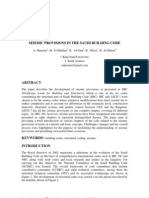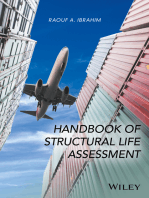Seismic Design
Seismic Design
Uploaded by
DipeshCopyright:
Available Formats
Seismic Design
Seismic Design
Uploaded by
DipeshOriginal Title
Copyright
Available Formats
Share this document
Did you find this document useful?
Is this content inappropriate?
Copyright:
Available Formats
Seismic Design
Seismic Design
Uploaded by
DipeshCopyright:
Available Formats
Dynamic Loads
7. Seismic Design
Lesson Objectives:
1) Describe code based seismic design in accordance with ASCE 7-16 and IBC 2012.
2) Compute “mapped” and design spectral accelerations.
3) Categorize and identify the seismic design category and importance factors for building
structures.
4) Qualitatively describe the equivalent lateral force method and identify when it is
appropriate to use as well as its limitations.
5) Compute the seismic coefficient and design base shear values.
6) Quantitatively construct a site-specific response spectrum.
7) Compute and apply the vertical distribution of seismic forces.
Background Reading:
1) Read ___________________________________________________________________.
Introduction:
1) Within seismic design, the seismic load demand on a structure can be calculated via two
simplistic methods.
a. _________________________________________________________________
b. _________________________________________________________________
2) For structures which have regular configurations, uniform mass, and stiffness and strength
distributions, the equivalent lateral force (ELF) method is most commonly used.
a. The focus of second half of these notes is the ELF method.
3) However, sometimes linear or nonlinear dynamic time history analysis is performed to
verify a particular design.
a. Typically done for _______ buildings, _______________ structures, and when a
________________________ is required.
Seismic Design © Richard L Wood, 2018 Page 1 of 30
Dynamic Loads
Modal Analysis with the Fundamental Mode Only:
1) The basis for the equivalent lateral force method common in most building codes
(including ASCE 7-16) is on both modal analysis and response spectrum analysis concepts.
2) As previously expressed, the maximum base shear contributed for a particular mode n of a
structure subjected to a horizontal base excitation can be written as:
3) Sketch:
4) In this above equation:
5) In the equation _______ is based on the effective ______________________. Therefore
one can define the effective ____________________________ as:
6) Recall the relationship between the ___________________________________________:
7) Substitution of these two relations into the first equation, one can write an expression for
the maximum base shear for the nth mode as:
Seismic Design © Richard L Wood, 2018 Page 2 of 30
Dynamic Loads
8) Therefore the maximum restoring force due to the nth mode, ______________, developed
within the structure can be written as:
9) Which can be rewritten as:
10) Using this equation above, the lateral __________________ acting on each story (level i)
can be expressed in terms of the story weight as:
11) Therefore it the response of a structure is dominated by its fundamental mode, one can
estimate the maximum base shear and restoring forces induced by an earthquake as:
12) Let’s revisit this when the seismic values are ready to be distributed to each floor.
Seismic Design © Richard L Wood, 2018 Page 3 of 30
Dynamic Loads
Code Based Seismic Design Loads
1) Now let’s focus on how to obtain design loads as prescribed by ASCE 7-16 and IBC 2012.
2) Note a new revision within the live loads and seismic hazard maps are incorporated into
the revised version, ASCE 7-16.
a. New to the ASCE 7-16 cycle is a new chapter on tsunami design.
Analysis Procedure – Determination of Design Accelerations:
1) The first step in the determination of the design acceleration is to determine the mapped
maximum considered earthquake (MCE) spectral response values.
a. MCE has a return period of ______________________________.
b. This is considered a “rare event”.
c. This equates to a ______ probability of exceedance in ______ years.
2) Two “mapped” spectral values are determined, namely ___________________________.
a. _________________ considered to the short period acceleration at ____________.
b. _________________ considered to the long period acceleration at ____________.
3) These values can be obtained via IBC 2012 Figures 1613.1(1) through 1613.3.1(6), where
a few examples are illustrated below in Figures 1-4.
4) An alternative approach to determine the mapped and design accelerations is to use the
online USGS tools. Screenshots and links are available in Figures 5 and 6.
a. Note this is a very powerful tool and can also minimally compute a design
spectrum.
5) When determining the spectral accelerations, Seismic Design Category A may be permitted
as an assignment if ________________________________________________________.
a. This is considered as a building located in a region with a very low probability of
experiencing damaging earthquake effects.
Seismic Design © Richard L Wood, 2018 Page 4 of 30
Dynamic Loads
Figure 1. Mapped maximum considered earthquake MCE spectral response acceleration at short
periods for the US mainland (part one).
Seismic Design © Richard L Wood, 2018 Page 5 of 30
Dynamic Loads
Figure 2. Mapped maximum considered earthquake MCE spectral response acceleration at short
periods for the US mainland (part two).
Seismic Design © Richard L Wood, 2018 Page 6 of 30
Dynamic Loads
Figure 3. Mapped maximum considered earthquake MCE spectral response acceleration at long
periods for the US mainland (part one).
Seismic Design © Richard L Wood, 2018 Page 7 of 30
Dynamic Loads
Figure 4. Mapped maximum considered earthquake MCE spectral response acceleration at long
periods for the US mainland (part two).
Seismic Design © Richard L Wood, 2018 Page 8 of 30
Dynamic Loads
Figure 5. Online seismic design maps for US and its territories. Available at:
https://earthquake.usgs.gov/designmaps/beta/us/
Seismic Design © Richard L Wood, 2018 Page 9 of 30
Dynamic Loads
Figure 6. Example seismic design values for Italy. Other mapping tools are available for other
countries. Available at: http://esse1-gis.mi.ingv.it/s1_en.php
6) After the mapped accelerations are determined, the ____________________ must be
specified. The site class is based on the local soil conditions (commonly as __________)
and can be classified as A-F in accordance with ASCE 7-16 Chapter 20. See Table 1.
7) A breakdown of the site classes include:
a. ______________________________________________________
b. ______________________________________________________
c. ______________________________________________________
d. ______________________________________________________
e. ______________________________________________________
f. ______________________________________________________
Seismic Design © Richard L Wood, 2018 Page 10 of 30
Dynamic Loads
8) If the soil conditions are not known, a designer may use site _______________ (as default)
unless the building officials or geotechnical data determines site class E or F is present.
9) Using the mapped accelerations and site classification, the maximum considered
earthquake spectral response accelerations can be adjusted for the site class effects at the
short period (________) and long period (________).
10) Note the above values correspond to a hazard represented as ________________________
_______________________________________________________________________.
11) To determine the 5% damped of critical design spectral response accelerations, denoted
as _______________________ at short and long periods, respectively; the following
equations from IBC 1613.3.4 can be utilized (using Tables 2 and 3):
12) The design earthquake event considers an approximate return period of _______________
and corresponds to a _________ probability of exceedance in _________ years.
Seismic Design © Richard L Wood, 2018 Page 11 of 30
Dynamic Loads
Table 1. Site classification table obtained from ASCE 7-16.
Table 2. Short period site coefficient table obtained from IBC 2012.
Table 3. Long period site coefficient table obtained from IBC 2012.
Seismic Design © Richard L Wood, 2018 Page 12 of 30
Dynamic Loads
Analysis Procedure –Seismic Design Category and Importance Factor:
1) The risk associated with each use of buildings and other structures is not constant.
a. For example: one-story residential house versus a nuclear power facility.
b. Various risk categories are defined in IBC Table 1604.5 and
c. These can be found in ASCE 7-16 Table 1604.5 or similarly in FEMA P-749
Chapter 5 Table 3.
d. Refer to Tables 4 and 5.
2) To account for the associated risks, Importance factors, _____, are introduced and can be
found in ASCE 7-16 Table 1.5-2. Refer to Table 6.
3) Seismic design categories (__________) can be assigned and determined as a function of
the “mapped” spectral accelerations and the risk category.
4) Definitions of seismic design categories is shown in Table 7. These definitions are obtained
from FEMA P-749, but are very close to the brief descriptions in ASCE/IBC procedures.
5) The seismic design category will govern which analytical procedures are appropriate.
Seismic Design © Richard L Wood, 2018 Page 13 of 30
Dynamic Loads
Table 4. Risk classification of representative buildings obtained from ASCE 7-16.
Seismic Design © Richard L Wood, 2018 Page 14 of 30
Dynamic Loads
Table 5. Occupancy classifications for representative buildings obtained from FEMA P-749.
Seismic Design © Richard L Wood, 2018 Page 15 of 30
Dynamic Loads
Table 6. Importance factors obtained from ASCE 7-16.
Seismic Design © Richard L Wood, 2018 Page 16 of 30
Dynamic Loads
Table 7. Seismic design category obtained from FEMA P-749.
Seismic Design © Richard L Wood, 2018 Page 17 of 30
Dynamic Loads
Table 8. Seismic design category based on the short period response accelerations.
Table 9. Seismic design category based on the long period response accelerations.
Seismic Design © Richard L Wood, 2018 Page 18 of 30
Dynamic Loads
Analysis Procedure –Computation of Seismic Base Shear:
1) As mentioned in the previous section, the seismic design category will control on which
analytical methods are appropriate.
2) Illustrated in ASCE Table 12.6-1 (Table 10).
3) Specified vertical and horizontal irregularities within this table can be found in ASCE
Tables 12.3-1 and 12.3-2 (Tables 11 and 12).
4) One of the common methods (equivalent lateral force) will be detailed in the next section.
Table 10. Appropriate analytical procedure by seismic design category and structural
characteristics. (Obtained from ASCE 7-16).
Seismic Design © Richard L Wood, 2018 Page 19 of 30
Dynamic Loads
Table 11. Horizontal irregularities obtained from ASCE 7-16.
Seismic Design © Richard L Wood, 2018 Page 20 of 30
Dynamic Loads
Table 12. Vertical irregularities obtained from ASCE 7-16.
Seismic Design © Richard L Wood, 2018 Page 21 of 30
Dynamic Loads
Analysis Procedure – Equivalent Lateral Force Analysis:
1) In IBC and ASCE design guidelines, an equivalent lateral force procedure can be utilized
in design in lieu of dynamic analysis.
2) As outlined previously in these notes, this is based on the response spectrum concept.
3) The general equation for seismic base shear in a given direction can be expressed as:
4) This equation is similar to that under point 11 of Modal Analysis with the Fundamental
Mode only.
a. This represents the pseudo-acceleration response spectrum for 5% damped, as
shown in Figure 7.
Seismic Design © Richard L Wood, 2018 Page 22 of 30
Dynamic Loads
Figure 7. Design response spectra obtained from ASCE 7016.
5) The weight in this equation, W, is the effective seismic weight.
a. Instead of having the effective modal weight for the fundamental mode, as done in
modal analysis, the total weight of the structure is used.
b. Why?
c. This is meant to compensate for the _______________________ignored in the
equation in a “conservative way”.
d. Is this always effective? ______________________________________________
6) In the calculation of the seismic weight, this should include the dead load above the base
and other loads above the base as appropriate.
a. This includes stipulates that for areas used for storage, a minimum of 25% of the
floor live load shall be included.
i. This is not needed if the inclusion of storage loads add no more than 5% to
Seismic Design © Richard L Wood, 2018 Page 23 of 30
Dynamic Loads
the effective seismic weight at the level.
b. Floor live loads in public garages and open parking structures does not need to be
included.
7) Where partitions are required in the floor load design, the actual weight of the partitions or
a minimum weight as specified in the code is needed, whichever is greater.
8) This also includes the operating weight of any permanently installed equipment.
9) The above equation for the seismic response coefficient, it should be less than the following
cases:
Seismic Design © Richard L Wood, 2018 Page 24 of 30
Dynamic Loads
10) In the above equations, a response modification coefficient, R, is to account for the
______________________ of a structure.
a. As described in earlier sections of notes, a more ductile structure has a higher value
of R.
b. However it is not exactly equal to the ductility capacity, but it also takes into
consideration of the expected overstrength in a structure.
c. The values of R for different types of structures are provided in ASCE 7-16 Table
12.14-1 (shown here as Table 13).
d. Historically these values were set on empirical evidence and experience.
e. However these values can be determined for systems and new structural systems
using the systematic approach within FEMA P695. This approach has a target
probability of collapse of a structure under a maximum considered earthquake
(MCE) is not greater than 10%. This procedure requires extensive nonlinear time
history analysis to compute these coefficients.
11) Another variable specified in the equations above is the fundamental period of a structure,
T.
12) A period value is required to compute the base shear and the distributed lateral forces (to
be described shortly). These values can be obtained using a structural model or through an
approximate equation.
13) One equation for an approximate value of the period is given below:
14) These constants can be obtained determined from Table 12.8-2 in ASCE 7-16 or shown
here in Table 14.
Seismic Design © Richard L Wood, 2018 Page 25 of 30
Dynamic Loads
15) Note that the calculated approximate fundamental period in the above equations cannot
exceed the product of the coefficient (Cu) in Table 12.8-1 of ASCE 7-16 times the
approximate fundamental period, Ta.
16) As a general rule of thumb for the anticipated ________________________, for a moment
resisting frame that that does not exceed twelve stories with a minimum story height of 9
feet, an approximate period can be estimated as:
17) Where in the equation above, N is the number of stories above the base.
a. This is a similar quantity provided in Structural Dynamics and in discussions.
b. Note concrete and steel buildings are expected to behave differently!
Seismic Design © Richard L Wood, 2018 Page 26 of 30
Dynamic Loads
Table 13. Response modification coefficients obtained from ASCE 7-16.
Seismic Design © Richard L Wood, 2018 Page 27 of 30
Dynamic Loads
Table 14. Approximate structural periods (fundamental mode) obtained from ASCE 7-16.
Table 15. Coefficient for the upper limit on the calculated period obtained from ASCE 7-16.
Seismic Design © Richard L Wood, 2018 Page 28 of 30
Dynamic Loads
Equivalent Lateral Force Analysis: - Vertical Distribution of Seismic Force:
1) Once the design base shear, V, has been determine, the vertical distribution of later forces
can be given by the following equations:
2) Parameter of ________ is the height from the base to level i.
3) Parameter of ________ is equal to unity (“1”) for T = 0.5 seconds or less, is equal to 2 for
T = 2.0 seconds or more; else between 0.5 and 2.5 seconds is taken as 2 or determined by
linear interpolation.
4) In the above equation is once again related to the modal analysis. Refer to point 11 of
Modal Analysis with the Fundamental Mode only within this section of notes.
5) The ______ denotes the mode shape.
a. The exponent _____ is used to account for the higher-mode effects.
b. In general, the higher mode effects are more ________________________ for a
structure with a longer fundamental period.
c. For structures with a ___________________fundamental period, it is implied that
the higher-mode effects are not important since k = 1 and the corresponding mode
shape is _____________________.
Seismic Design © Richard L Wood, 2018 Page 29 of 30
Dynamic Loads
References:
Applied Technology Council. (2009). FEMA P695 / Quantification of Building Seismic
Performance Factors. Redwood City, CA, June.
ASCE/SEI (2017). ASCE 7-16: Minimum Design Loads for Buildings and Other Structures.
American Society of Civil Engineers, Reston, VA.
ASCE/SEI (2010). ASCE 7-10: Minimum Design Loads for Buildings and Other Structures.
American Society of Civil Engineers, Reston, VA.
FEMA (2010). FEMA P-749 / Earthquake-Resistant Design Concepts. An Introduction to the
NEHRP Recommended Seismic Provisions for New Buildings and Other Structures.
National Institute of Building Sciences. Washington, DC.
International Code Council, ICC. (2012). International building code 2012. International Code
Council, Country Club Hills, IL.
Seismic Design © Richard L Wood, 2018 Page 30 of 30
You might also like
- As-1170.4-2007 - Worked ExamplesDocument10 pagesAs-1170.4-2007 - Worked ExamplesMihnea CostacheNo ratings yet
- Crisis ManualDocument154 pagesCrisis Manualcrls_marcosNo ratings yet
- Ul8ai (Red) - d25 SPD ForDocument4 pagesUl8ai (Red) - d25 SPD ForAnil Bhairat100% (1)
- DevOps Thesis Final PDFDocument79 pagesDevOps Thesis Final PDFnaviat204No ratings yet
- Designing A Cellular Network CompleteDocument10 pagesDesigning A Cellular Network CompleteHaashimMohamedNo ratings yet
- Seismology and EarthquakesDocument42 pagesSeismology and EarthquakesMujahid RahmanNo ratings yet
- SeismicWavesJun12 PDFDocument3 pagesSeismicWavesJun12 PDFAnonymous pD2ymRUguNo ratings yet
- Selecting Analysis MethodsDocument10 pagesSelecting Analysis MethodsRupesh UpretyNo ratings yet
- Ucg Es 00136Document12 pagesUcg Es 00136eenyinyiNo ratings yet
- Sap - 2000 Manual PDFDocument60 pagesSap - 2000 Manual PDFAnonymous e3TzDf4Ew100% (1)
- RelatedDocument9 pagesRelatedobadaharfoush620No ratings yet
- Car Garrage Report - 25-6-2023Document11 pagesCar Garrage Report - 25-6-2023amalastructuralNo ratings yet
- Cost Benefit Analysis of Earthquake Protection Programme Through Retrofitting of Non-Engineered BuildingsDocument8 pagesCost Benefit Analysis of Earthquake Protection Programme Through Retrofitting of Non-Engineered BuildingsRAVINDRA KHANDELWALNo ratings yet
- Seismic Hazard Assessment in India: B. GhoshDocument10 pagesSeismic Hazard Assessment in India: B. GhoshmahdiNo ratings yet
- 6 Seismic Loss ExampleDocument24 pages6 Seismic Loss ExampleOscar AnicamaNo ratings yet
- IS 1893 (Part 1) :2002: June 2002Document6 pagesIS 1893 (Part 1) :2002: June 2002Niyat PatelNo ratings yet
- Earthquake EngineeringDocument9 pagesEarthquake EngineeringJoachim GardNo ratings yet
- Fundamental Principles of Earthquake Resistance Calculation To Be Reflected in The Next Generation RegulationsDocument6 pagesFundamental Principles of Earthquake Resistance Calculation To Be Reflected in The Next Generation RegulationsBenmark JabayNo ratings yet
- Hazard Maps Fragility Maps & Shake Maps: Project Rainbow IIDocument62 pagesHazard Maps Fragility Maps & Shake Maps: Project Rainbow IIDavid Gutierrez RiveraNo ratings yet
- Barbat 2008Document15 pagesBarbat 2008mohamedNo ratings yet
- Development of Seismic Vulnerability Curves of Key Building Types in The PhilippinesDocument8 pagesDevelopment of Seismic Vulnerability Curves of Key Building Types in The PhilippinesSharah QuilarioNo ratings yet
- Assignment NSCP 2015 Final Term StudentsDocument1 pageAssignment NSCP 2015 Final Term StudentsJef Junio AlvarezNo ratings yet
- Ground Motion Evaluation Procedures of Performance Based DesignDocument8 pagesGround Motion Evaluation Procedures of Performance Based DesignRaju PalNo ratings yet
- Seismic Analysis Asce 7 and IBCDocument8 pagesSeismic Analysis Asce 7 and IBCAnil kumar RNo ratings yet
- CHABOCHE, J. L. - Continuum Damage Mechanics P.2 - Damage Growth, Crack InitiationDocument8 pagesCHABOCHE, J. L. - Continuum Damage Mechanics P.2 - Damage Growth, Crack InitiationhasmonteiroNo ratings yet
- Moment Area MethodDocument12 pagesMoment Area MethodFolorunsho MosesNo ratings yet
- Aerts 2014 Science SMDocument52 pagesAerts 2014 Science SMSnertNo ratings yet
- NCHRP 20-7 (193) Task 6 Report As Sent To AASHTO Website 10-29-01 PDFDocument156 pagesNCHRP 20-7 (193) Task 6 Report As Sent To AASHTO Website 10-29-01 PDFvirajNo ratings yet
- 07 May 282 298Document17 pages07 May 282 298Deny SitorusNo ratings yet
- EESD Seyedietal FinalDocument20 pagesEESD Seyedietal FinalFlandy BuntoroNo ratings yet
- Steel and TimberDocument11 pagesSteel and Timberkaye carrancejaNo ratings yet
- Comparison of Ground Motion Selsction Criteria For Seismic DesignDocument14 pagesComparison of Ground Motion Selsction Criteria For Seismic Designanna_318857983No ratings yet
- Seismic Performance Objectives: Adequate For Community Resilience?Document12 pagesSeismic Performance Objectives: Adequate For Community Resilience?AndresNo ratings yet
- 24 - Earthquake Codes and Design in Canada... A.C. HeidebrechtDocument34 pages24 - Earthquake Codes and Design in Canada... A.C. HeidebrechtPrashant MuleNo ratings yet
- GutiérrezDocument18 pagesGutiérrezalexanderhcNo ratings yet
- Wcee2017 942Document11 pagesWcee2017 942Misganaw YeshiwasNo ratings yet
- Typological Damage Fragility Curves For UnreinforcDocument18 pagesTypological Damage Fragility Curves For UnreinforcSaif Ur RehmanNo ratings yet
- Risk Targeting in Seismic Design Codes: The State of The Art, Outstanding Issues and Possible Paths ForwardDocument13 pagesRisk Targeting in Seismic Design Codes: The State of The Art, Outstanding Issues and Possible Paths ForwardfaisaladeNo ratings yet
- What Is Difference Between Time History Analysis and Response Spectrum AnalysisDocument8 pagesWhat Is Difference Between Time History Analysis and Response Spectrum AnalysisowaisNo ratings yet
- 3 Navas Sánchez (2023) Seismic vulnerabilityDocument128 pages3 Navas Sánchez (2023) Seismic vulnerabilitylaura navasNo ratings yet
- Performance Based Design With Application To Seismic HazardDocument3 pagesPerformance Based Design With Application To Seismic HazardZaheer AhmedNo ratings yet
- Seismic Provisions in The Saudi Building CodeDocument12 pagesSeismic Provisions in The Saudi Building CodeMILL3482No ratings yet
- A New Round of Updation of Seismic Design Code of China: Yayong WangDocument6 pagesA New Round of Updation of Seismic Design Code of China: Yayong Wangpescanova3No ratings yet
- FEA Analysis and Optimization of Boom of Excavator: Niteen S. Patil, Prof. Vinay. M. MalbhageDocument8 pagesFEA Analysis and Optimization of Boom of Excavator: Niteen S. Patil, Prof. Vinay. M. MalbhageMohammed ZainNo ratings yet
- Comandos Ejemplo MatlabDocument10 pagesComandos Ejemplo MatlabJaime GuamanNo ratings yet
- Chapter 4 Seismic Design and Retrofit: Bridge Design Manual Page 4-I July 2005Document25 pagesChapter 4 Seismic Design and Retrofit: Bridge Design Manual Page 4-I July 2005precastengineeringNo ratings yet
- KSU 14 04 Shear CircularDocument2 pagesKSU 14 04 Shear CircularRory Cristian Cordero RojoNo ratings yet
- Humar and Mahgoub - Canadian Earthquake DesignDocument22 pagesHumar and Mahgoub - Canadian Earthquake Designrodrigo93_vgNo ratings yet
- CH 9 - Role of Codes and Empirical ProceduresDocument27 pagesCH 9 - Role of Codes and Empirical Proceduresjulesjusayan100% (1)
- Development of Multistoried RCC Building Model With Soft Storey in Staad ProDocument8 pagesDevelopment of Multistoried RCC Building Model With Soft Storey in Staad ProGRD JournalsNo ratings yet
- 2.0 Modifications To Risk-Targeted Seismic Design Maps For Subduction and Near-Fault HazardsDocument8 pages2.0 Modifications To Risk-Targeted Seismic Design Maps For Subduction and Near-Fault HazardsArnold Mendo RodriguezNo ratings yet
- Vulnerability of RC Frame Structures in Turkish EaDocument16 pagesVulnerability of RC Frame Structures in Turkish EaHabib YousofiNo ratings yet
- Modelling Geological SubsurfacesDocument8 pagesModelling Geological SubsurfacesBenjamin Sanchez MaldonadoNo ratings yet
- Earthquake Vulnerability and Risk Modeling For The Area of Greater Cairo, Egypt - T.liesch Et AlDocument1 pageEarthquake Vulnerability and Risk Modeling For The Area of Greater Cairo, Egypt - T.liesch Et Aljmcc2No ratings yet
- CRISIS Manual PDFDocument154 pagesCRISIS Manual PDFjoseph_roodNo ratings yet
- Estimation Method of Seismic Damage Prediction of Single BuildingDocument6 pagesEstimation Method of Seismic Damage Prediction of Single Buildingmy09No ratings yet
- Flood Damage Survey and Assessment: New Insights from Research and PracticeFrom EverandFlood Damage Survey and Assessment: New Insights from Research and PracticeDaniela MolinariNo ratings yet
- Quantifying Uncertainty in Subsurface SystemsFrom EverandQuantifying Uncertainty in Subsurface SystemsCéline ScheidtNo ratings yet
- Type of Contract For Civil, Mechanical and Electro-Mechanical Works and Status ReportDocument1 pageType of Contract For Civil, Mechanical and Electro-Mechanical Works and Status ReportDipeshNo ratings yet
- New Microsoft Office Excel WorksheetDocument1 pageNew Microsoft Office Excel WorksheetDipeshNo ratings yet
- Eqipment&manpower Mobilization PDFDocument2 pagesEqipment&manpower Mobilization PDFDipeshNo ratings yet
- Wheel Load Diagram For 50-10 Ton Eot CraneDocument1 pageWheel Load Diagram For 50-10 Ton Eot CraneDipeshNo ratings yet
- Color - Estimation CostDocument5 pagesColor - Estimation CostDipeshNo ratings yet
- Calculation Sheet For Assistant ProfessorDocument34 pagesCalculation Sheet For Assistant ProfessorDipeshNo ratings yet
- 24 19 JUNE 2019 GTS Track ModeDocument154 pages24 19 JUNE 2019 GTS Track ModeDipeshNo ratings yet
- Technical Description of Galvanized Steel Earth Wire.: Page 4.1.6A - 1Document24 pagesTechnical Description of Galvanized Steel Earth Wire.: Page 4.1.6A - 1DipeshNo ratings yet
- Technical Description of Galvanized Steel Earth Wire.: Page 4.1.6A - 1Document24 pagesTechnical Description of Galvanized Steel Earth Wire.: Page 4.1.6A - 1DipeshNo ratings yet
- Blue Energy Private Limited Super Trishuli Hydropower Proejct Construction of Field Camp-1Document4 pagesBlue Energy Private Limited Super Trishuli Hydropower Proejct Construction of Field Camp-1DipeshNo ratings yet
- Unit - V Data Base in Computer Integrated ManufacturingDocument26 pagesUnit - V Data Base in Computer Integrated Manufacturingthanigaivel06No ratings yet
- Python Workbook Exercises For Beginners With SolutionsDocument24 pagesPython Workbook Exercises For Beginners With Solutionspaeg6512No ratings yet
- ArcGIS Bing Maps Data SheetDocument2 pagesArcGIS Bing Maps Data SheetcoreypackardNo ratings yet
- Air Conditioner MKA 2001 M: Art.-No.: 23.601.15 Bar Code: 4006825535778 Sales Unit: 1 PCDocument1 pageAir Conditioner MKA 2001 M: Art.-No.: 23.601.15 Bar Code: 4006825535778 Sales Unit: 1 PCSveti JeronimNo ratings yet
- MDM Warranty Periode 02042024Document69 pagesMDM Warranty Periode 02042024Samuel Kurnia PutraNo ratings yet
- Maharana Pratap Engineering College: Computer Science and EngineeringDocument14 pagesMaharana Pratap Engineering College: Computer Science and EngineeringNivedita SinghNo ratings yet
- Troubleshooting BGP BasicsDocument11 pagesTroubleshooting BGP BasicsPatrício LuisNo ratings yet
- ICT-6-TP.-2023-2024 With Mam NievaDocument5 pagesICT-6-TP.-2023-2024 With Mam NievaAmabelle Pagalunan AcletaNo ratings yet
- Introduction To Media and Information Literacy (MIL)Document98 pagesIntroduction To Media and Information Literacy (MIL)Frances A. Palec100% (4)
- Three Phase Transmission Lines Fault Detection, Classification and LocationDocument4 pagesThree Phase Transmission Lines Fault Detection, Classification and LocationNkkNo ratings yet
- Arm ProseccorDocument198 pagesArm Proseccorshreyansh.saurav21No ratings yet
- Django ProgrammingDocument7 pagesDjango ProgrammingAli100% (1)
- Will Humans Become Redundant in Your LifetimeDocument5 pagesWill Humans Become Redundant in Your LifetimeIan ThorpeNo ratings yet
- Czujniki KCCDocument11 pagesCzujniki KCCDinhnamsgpNo ratings yet
- Example of Seo ReportDocument21 pagesExample of Seo ReportIoana PopaNo ratings yet
- Unit 3Document41 pagesUnit 3Saurabh SachdevaNo ratings yet
- Flowchart, Algoruthm and Pseudo Codes in C++Document6 pagesFlowchart, Algoruthm and Pseudo Codes in C++MAveRicK135100% (4)
- DBMSDocument13 pagesDBMStigerNo ratings yet
- AKW-IMSP-001-Document Control ProcedureDocument4 pagesAKW-IMSP-001-Document Control ProcedureAdil AbdulkhaderNo ratings yet
- Oracle R12 P2P StepsDocument23 pagesOracle R12 P2P StepsChitta RajasekharNo ratings yet
- DSP Unit 4 Iir FiltersDocument81 pagesDSP Unit 4 Iir FiltersSRHNo ratings yet
- Horizon Compact SNMP Documentation v1.2 (83-000030-01-01-02) PDFDocument34 pagesHorizon Compact SNMP Documentation v1.2 (83-000030-01-01-02) PDFDennis GamboaNo ratings yet
- 2022 Global Software Outsourcing Trends and Rates GuideDocument47 pages2022 Global Software Outsourcing Trends and Rates GuideMukeshLagadhirNo ratings yet
- MLB 150 AccsDocument11 pagesMLB 150 Accsok na ata toNo ratings yet
- Microsoft Official Course: Networking With Windows Server 2016Document19 pagesMicrosoft Official Course: Networking With Windows Server 2016Abhay LimbadNo ratings yet
- Water Quality Monitoring System Based On IOT: Vaishnavi V. Daigavane and Dr. M.A GaikwadDocument10 pagesWater Quality Monitoring System Based On IOT: Vaishnavi V. Daigavane and Dr. M.A Gaikwadesubalew tadesseNo ratings yet
- What Is A FuseDocument11 pagesWhat Is A FuseAshutoshNo ratings yet


































































































